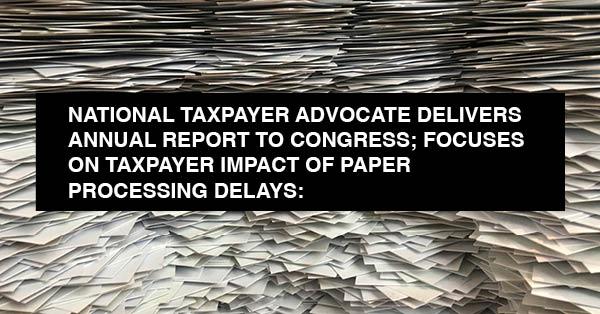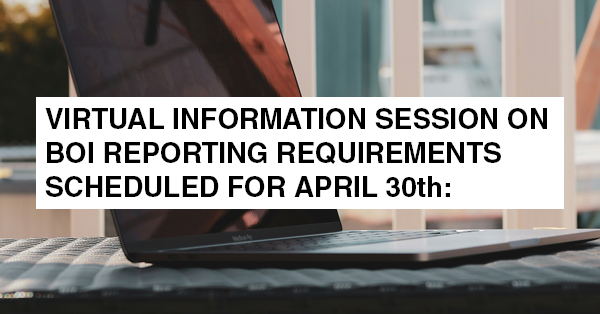NATIONAL TAXPAYER ADVOCATE DELIVERS ANNUAL REPORT TO CONGRESS; FOCUSES ON TAXPAYER IMPACT OF PAPER PROCESSING DELAYS:

National Taxpayer Advocate Erin M. Collins has released her 2023 Annual Report to Congress, describing 2023 as a year of “extraordinary transition for the IRS and therefore for taxpayers.”
The report credits the Internal Revenue Service with substantially improving taxpayer services and developing plans to transform the taxpayer experience in the coming years, but it identifies paper processing as an area of continuing weakness.
By law, the Advocate’s report is required to identify the 10 most serious problems taxpayers are experiencing in their dealings with the IRS and to make administrative and legislative recommendations to address those problems. Before cataloging taxpayer challenges, however, Collins praised the IRS for taking notable strides forward.
“Overall, the magnitude of successes exceeded the areas of weakness in 2023, and most metrics showed significant improvement from the depths of the [COVID-19] pandemic,” Collins wrote in the report’s preface. The report says the IRS virtually eliminated its backlog of unprocessed original individual income tax returns (Forms 1040) and substantially improved telephone service.
Taxpayer service challenges
“When I released the National Taxpayer Advocate’s 2020 report, I wrote that the IRS in most cases ‘can effectively handle whatever it can automate,’ and when I released our 2021 report, I wrote that ‘paper is the IRS’s kryptonite,’” Collins said in releasing the new report. “Those observations continued to hold true in 2023. The areas in which taxpayers continued to experience delays were primarily those that required employees to process tax returns and taxpayer correspondence.”
Extraordinary delays in assisting victims of identity theft. At the end of fiscal year (FY) 2023, nearly half a million taxpayers with cases pending in the IRS’s Identity Theft Victims Assistance (IDTVA) unit were waiting an average of almost 19 months for the agency to resolve their identity theft problems. “If it weren’t for the significant number of challenges affecting larger groups of taxpayers, this would be headline news, and it should be,” Collins wrote. “Many taxpayers depend on their tax refunds to meet their living expenses, particularly low-income taxpayers who receive Earned Income Tax Credit (EITC) benefits that [approached] $7,000 for tax year 2022.” Noting that 69% of taxpayers whose identity theft cases the IDTVA unit resolved had adjusted gross incomes at or below 250% of the federal poverty level, Collins called the delays “unconscionable” and urged the IRS to place a higher priority on resolving cases quickly.
Delays in processing amended tax returns and taxpayer correspondence. Despite the IRS’s success in eliminating its backlog of paper-filed Forms 1040, backlogs in processing amended individual income tax returns (Forms 1040-X), amended business tax returns and correspondence continued. At the end of calendar year 2019 (the most recent pre-pandemic year), the IRS’s backlog of unprocessed amended returns stood at 0.5 million. By comparison, the backlog as of late October 2023 was 1.9 million – nearly four times as much. Taxpayer correspondence and related cases more than doubled over the same period, from 1.9 million to 4.3 million. In addition, the percentage of correspondence cases classified as “overage” in 2023 reached its highest level in recent years, with nearly 70% of pending cases exceeding normal processing times as of late October. Delays in processing amended returns and correspondence harm taxpayers because processing delays cause delays in issuing refunds.
The report attributes much of the paper inventory backlog to the Treasury Department’s decision to prioritize answering telephone calls over processing amended returns and correspondence. Both tasks are performed by IRS customer service representatives (CSRs) in the agency’s Accounts Management (AM) function. For the 2023 filing season, Treasury set a goal of achieving an 85% “Level of Service” (LOS) on the IRS’s toll-free telephone lines, and that required staffing the telephone lines at levels capable of handling most calls during peak periods. However, the report says that meant CSRs often were “simply sitting around waiting for the phone to ring.” During the 2023 filing season alone, CSRs spent 1.27 million hours (34% of their time) waiting to receive calls. That translates to more than 650 unproductive staff years in which these employees could have been processing paper and reducing response times for amended returns and correspondence.
“The IRS cannot easily shuffle employees back and forth between answering phones and processing correspondence, so unproductive employee time was the price it had to pay to improve telephone service levels,” Collins wrote. “Going forward, the IRS needs to find a way to move employees between those two functions more nimbly. For present purposes, however, we need to keep in mind that backlogs in processing tax returns and taxpayer correspondence drive much of the phone volume. I encourage the IRS to put more emphasis on reducing its paper processing backlog in 2024.”
Challenges in receiving telephone assistance despite overall improvements. The report says the IRS deserves credit for achieving its goal of providing an 85% Level of Service on its AM telephone lines during the filing season, but it points out that the LOS is a highly technical measure that excludes the majority of calls the IRS receives from its calculation. During the same period that the IRS achieved an LOS of 85%, IRS employees answered only 35% of all calls received. For the full fiscal year, IRS employees answered 29% of all calls received.
The IRS maintains dozens of distinct telephone lines, and averages can mask significant variations among key lines. The report says service for tax professionals was below average, with a reported LOS of 34% in FY 2023 and an average wait time of 16 minutes before reaching a CSR. “Roughly 500,000 tax professionals prepare tax returns for more than 85 million taxpayers, so the IRS derives considerable benefit from working collaboratively with the pool of tax professionals,” the report says. “Requiring tax professionals to call back repeatedly and wait on hold not only inconveniences them but often results in additional costs to taxpayers for the time their tax professionals bill for waiting on hold.” The report recommends the IRS prioritize improving service on the practitioner telephone line. It also recommends the IRS develop better performance measures so it not only measures access to a CSR but also measures call quality (e.g., the percentage of taxpayer issues resolved with a single telephone call).
Employee Retention Credit (ERC) processing. Employers who file eligible ERC claims are often waiting six months or longer to receive their credits or refunds. TAS has received several thousand ERC cases, and some have involved non-profit organizations that provide medical or other critical services and are depending on ERC refunds to stay afloat. As of early December, the IRS had a backlog of approximately one million ERC claims. The IRS has said many of the submitted claims are fraudulent or otherwise non-qualifying.
The report acknowledges the IRS is between a rock and a hard place in handling ERC claims. “If it pays claims quickly without adequate review, it could pay billions of dollars to nonqualifying persons. If it takes the time to review claims carefully, eligible employers will experience significant delays in receiving the credit, and in extreme cases, employers who need the funds immediately could go out of business,” the report says.
Read the full report here.




